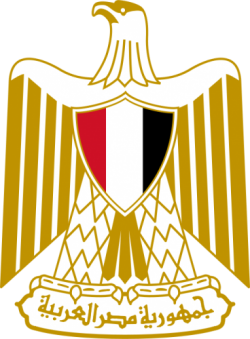Coat of arms of Egypt

The coat of arms of Egypt (Egyptian Arabic: شعار مصر) is a golden eagle looking towards the viewer's left (dexter).
The "Eagle of Saladin" holds a scroll on which the name of the state appears in Arabic script, Gumhūriyyat Miṣr al-ʿArabiyyah ("Arab Republic of Egypt"). The eagle carries on its breast a shield with the flag's colors — but with a vertical instead of a horizontal configuration. When appearing on the national flag, the eagle is rendered entirely in gold and white. During the union with Syria in the United Arab Republic (1958–1961), and in the ten years afterwards when Egypt retained the union's official name, the two green stars of the union's flag appeared in the white band of the eagle's shield. Between 1972–1984 the eagle was replaced by the golden hawk of Qureish, as part of the symbolism of the Federation of Arab Republics.
The eagle as a symbol of Saladin is disputed by archeologists. The symbol of an eagle was found on the west wall of the Cairo Citadel (constructed by Saladin), and so is assumed by many to be his personal symbol. There is, however, little proof to defend this. It was subsequently adopted as a symbol of Arab nationalism by Iraq, Palestine, and Yemen (and formerly by Libya).
© Symbols.com
